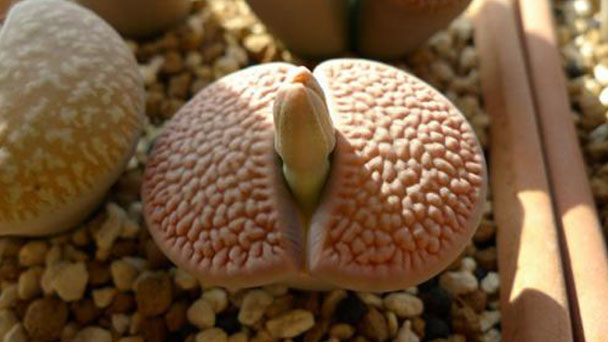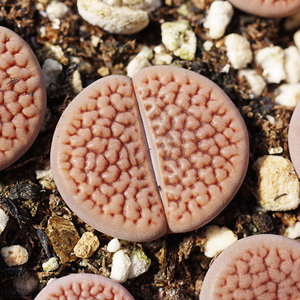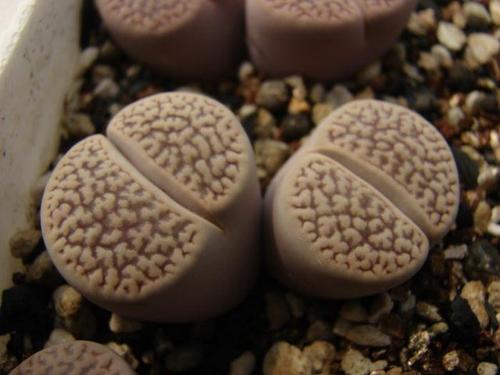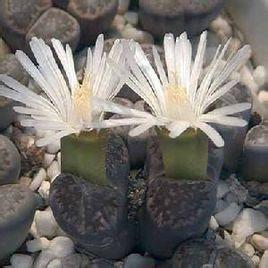Lithops turbiniformis profile
Written by Maggie
Mar 31 2021

Lithops Turbiniformis are native to Cape Province, South Africa, and are now widely cultivated. The plants of Lithops Turbiniformis are nearly gyroscopic, 2 -- 2.5 cm tall, flattened or slightly raised at the top, and nearly rounded. There are light gray-brown, blue-gray, gray-green, gray-brown and other colors. Flowers grow from a small slit in the middle of the top, yellow or white, a plant usually has only 1 flower (rarely 2 -- 3 flowers), open in the afternoon, close in the evening, can last 4 -- 6 days, 3 -- 5cm in diameter. Fruits and seeds are readily produced after anthesis.
Lithops Turbiniformis picture

Morphological characteristics of Lithops Turbiniformis
Plant stem
Lithops Turbiniformis are small perennial succulents. Plants are nearly gyroscopic, 2 -- 2.5 cm tall, apically flattened or slightly convex, suborbicular. The flanks are gray to tawny, and the tops reddish brown to purplish brown with curving dendritic stripes of purplish-brown. The stem is very short and often invisible.
Leaf
Metamorphous leaves of Lithops Turbiniformis are fleshy and hypertrophic, and the two pieces are joined opposite to form an inverted cone. Varieties more, each has its own characteristics.
Flowers
3-4 - year - old stone flowers autumn from the middle gap of opposite leaves out yellow, white, red, pink, purple and other colorful flowers, more open in the afternoon, close in the evening, the next afternoon and open, a single flower can open 7-10 days. When it blooms, the flowers almost cover the whole plant and are very beautiful. When the flowers fade, they bear fruit and harvest very small seeds. lithops turbiniformis shape such as colorful stone, colorful, petite Ling class, enjoy the reputation of "living stone". The stem is spherical, depending on the variety, its top surface color and pattern are different, but the shape is very pebble. Autumn opens large yellow or white flowers, like a small chrysanthemum. Lithops Turbiniformis is fleshy, the stem is very short. The fleshy leaves are oppositely joined, shaped like an inverted cone. There are light gray-brown, blue-gray, gray-green, gray-brown and other colors, near the top of the oval, flat or convex, on a dendriform concave grain, translucent. Flowers grow from a small slit in the middle of the top, yellow or white, a plant usually has only 1 flower (rarely 2 -- 3 flowers), open in the afternoon, close in the evening, can last 4 -- 6 days, 3 -- 5cm in diameter. Fruits and seeds are readily produced after anthesis.
Ecological habits of Lithops Turbiniformis
Lithops Turbiniformis like sunshine and grow at an appropriate temperature of 20 ° C to 24 ° C. In spring and autumn, it is appropriate to culture on the balcony or windowsill in the south, when its growth is in its peak period. Water should be watered every 3-5 days to promote growth and flowering. The growth rule of Lithops Turbiniformis is that they begin to grow from March to April, stop growing in the high-temperature season, enter the dormant period in summer, continue to grow and bloom in the cool autumn, and enter the overwintering period after the flowers fade.
Lithops Turbiniformis like warm, dry and sunny environments. Lithops Turbiniformis is afraid of low temperature, avoid strong light, appropriate loose neutral sandy loam. The temperature in winter is not lower than 12℃. Potted stone flowers, because of their deep roots, it is appropriate to use bobbin. The basin soil is sandy soil with rich limestone and good drainage. Pit the pit with a stick, half the depth of the seedlings, plant the seedlings in, and moisten the soil with the main water method.
How to grow and care for Lithops Turbiniformis
Watering is the most frequent part of Lithops Turbiniformis daily management. It is closely related to plant growth, cultivation substrate and utensils, weather conditions and seasonal changes. In the growth of a better period, should be fully considered the growth needs of plants, can be poured more; On the contrary, less water. Overcast or rainy days can stop watering. Small planting containers to water more times; Otherwise, it should be reduced accordingly. Better growing plants can be watered a few more, there are injuries that can be basic not watering or less watering. In addition, the growing season can be sprayed on the plant, but flowering plants or plants with wounds should not be sprayed. In short, we should master it flexibly according to specific circumstances. Spring is full of growth and water supply. After autumn blossoms, want to reduce watering gradually, winter wants strict control watering, keep basin soil dry had better.
From the perspective of seasonal changes, Lithops Turbiniformis grow strongly in spring, the temperature increases, the light increases, and the water demand are correspondingly larger. When the temperature rises to about 30℃, it is necessary to open the window to ventilate in order to reduce the room temperature. With the circulation of air, water evaporation increases, to gradually increase the amount of watering and watering times. Summer temperature is getting higher and higher, Lithops Turbiniformis gradually into a hibernation state must be controlled watering. In the higher temperature, relative humidity of the larger rainy season, the basic to stop watering, so that Lithops Turbiniformis fully dormant. When watering blindly so, may die very quickly. The autumn temperature gradually decreases, the temperature difference between day and night is correspondingly increased, and rock flowers slowly recover growth. At this time the appropriate increase in the number of watering and watering amount can maintain better growth. Winter is a special season. As far as the north is concerned, the room temperature varies greatly due to the different indoor heating conditions. So watering should be determined according to room temperature and daylight conditions. If the room temperature can reach 15-28 ℃ or so, it can be managed normally, and more water should be poured appropriately. The lower the room temperature, the less you water. If the room temperature is only about 9℃, should basically stop watering, in order to increase the cold resistance of the plant.
The specific time of watering: the growing season should be in the morning, winter should be in the middle of a sunny day. Lithops Turbiniformis exposed to the hot sun should never be watered at noon.
Lithops Turbiniformis have a process of peeling and splitting during growth. Usually, in late winter and early spring, the cracks in the plant begin to open, and one or two or three new plants begin to grow at the crack, while the old plants wither away and are replaced by new plants. The process of replacing the old plants with the new ones is the process of peeling growth and division and reproduction. During this process, do not spray water on the plant to prevent infection. Lithops Turbiniformis is pleasant to sunshine, the suitable temperature for growth is 20 ~ 24℃, can be placed on the well-ventilated balcony, windowsill culture. In summer, laying a layer of pebbles on the surface of the basin soil is conducive to the growth of its roots.
The growth period of Lithops Turbiniformis is from March to May, and dormancy occurs when the temperature rises after June, and dormancy occurs when the temperature is lower than 8℃. Winter should be placed in a room above 15℃ for maintenance. If the room temperature is low, Lithops Turbiniformis can be placed indoors in a closed fish tank facing the sun. Fertilizer every half a month 1 time, but the fertilizer liquid must not stain globular leaves. Suspend fertilization after autumn flowering.

Propagation of Lithops Turbiniformis
Seed propagation
Sowing in spring, small seeds, indoor pot sowing, sowing temperature 22-24℃. Germinate about 7-10 days after sowing. Seedlings are only soya-sized, grow slowly and must be managed carefully. The seedlings will take 2-3 years to bloom. When growth begins in the spring, the old plants gradually shrink and are cracked by the new growth. We need to reduce watering right now, keep basin soil a little drier, avoid spraying water directly to the plant, in case wound infection causes rot. Move Lithops Turbiniformis to an indoor half-light place after summer, avoid strong light to shoot directly, at the same time want to open the window in time to ventilate and cool down, and want to control watering, can make its safe summer.
Care in autumn
After autumn to gradually increase the amount of water, and apply a small amount of compound fertilizer, for the benefit of pregnant bud bloom. After the flower wither wants to reduce watering gradually again, winter wants to control watering strictly more, in order to know to hold basin soil dry some had better. During the wintering period, Lithops Turbiniformis should be placed in a sunny place, and the room temperature should be kept above 10 degrees to overwinter safely, but it is best to place it at a room temperature of more than 15 degrees Celsius. Roots of Lithops Turbiniformis developed, so it is appropriate to choose deep basin cultivation. The basin soil can be mixed with 4 parts of leaf rot soil, 3 parts of calcareous materials (shell powder, eggshell powder, old ash wall debris, etc.) and 3 parts of river sand. Planting can not be too deep, otherwise it is easy to cause planting and wiping rot. Propagation of Lithops Turbiniformis, sowing and dividing can be used.
Seeding temperature
The seeding temperature is 22-24℃. After sowing about half a month can emerge, emerge after let the seedling gradually see light. Lithops Turbiniformis every spring from the middle of the gap in the growth of the new fleshy leaves, the old leaves swell and break open, the old leaves also with shrinkage and death. The new leaves grow rapidly, and in summer they shrivel and crack. And grow from the gap of 2 ~ 3 young new plants, seedlings can be divided.
Disease & pest control of Lithops Turbiniformis
Disease control
Lithops Turbiniformis are mainly harmed by leaf spot and leaf rot, which can be sprayed with 65% Dexin Zinc WP 600 times liquid.
Pest control
The insect pests of Lithops Turbiniformis are harmful to ants and root-knot nematodes, and the soil exchange method is used to reduce nematode invasion. Prevent ant, usable cover basin to lie between water to conserve, make ant climbs less than tender and succulent globular leaf. Potted Lithops Turbiniformis, the root system is small and shallow, and colorful pebbles can be put around it, which not only plays a supporting role but also increases the ornamental effect.
Distribution region of Lithops Turbiniformis
Lithops Turbiniformis are native to Cape Province, South Africa, and are now widely cultivated. The shape of the plant is like stone, and its flowers seem to come out from the cracks in the stone, so it is called "stone flowers".
Lithops Turbiniformis uses
Medicinal value
The young shoots of Lithops Turbiniformis are rich in saponins. Medicinal heat and detoxification, dispelling wind and detumescence, internal administration for enteritis, external application for eye swelling.
Landscape uses of Lithops Turbiniformis
Lithops Turbiniformis are small and exquisite. Exquisitely shaped, like glittering and translucent gems flashing brilliance, enjoy the reputation of "living gems" in the world, suitable for indoor small potted flowers. There are 70 to 80 species of Stone genus, among which L. ucampiac is the most commonly cultivated.L. Eberlanzii; Amber jade (L. ella) and so on.The shape and color of stone flowers resemble colored pebbles, and there are many varieties and rich colors. Lithops Turbiniformis is a world-famous small pulpy plant, often used for indoor ornamental pot.

Latest Updated
- Benefits of Bugleweed - 7 Science-backed Health Benefits
- Bugleweed Dangers & Side Effects - Is It Poisonous?
- How to Plant Evergreen Trees - What You Should Know
- When to Plant Evergreens - Grow Guide for Evergreen Trees
- 12 Wonderful Evergreen Shrubs for Your Garden
- 12 Popular Evergreen Plants with Pictures for Beginners
- When And How To Prune A Lilac Bush Like a Pro
- How to Grow & Care for Lilac Vine (Hardenbergia Violacea)
- Japanese Lilac Tree (Syringa Reticulata) Care & Propagation Guide
- Shumard Oak Pros and Cons - What to Know
Popular Articles
- Winter maintenance of Antirrhinum Majus
- How to Grow Terminalia Mantaly Tree
- How to Grow and Care for Crossostephium Chinense
- How to grow Antirrhinum Majus in spring
- Peristeria Elata (Dove Orchid) Profile: Info & Care Guide
- Underwatered Snake Plant (Sansevieria Trifasciata) - Signs And How To Fix
- How to Care for Brazilian Jasmine Plant (Mandevilla Sanderi)
- How to Grow & Care for Graptopetalum Purple Delight in Summer
- Rosa Chinensis (China Rose): Plant Growing & Care Tips
- How to Care for Baby Sun Rose (Aptenia Cordifolia)